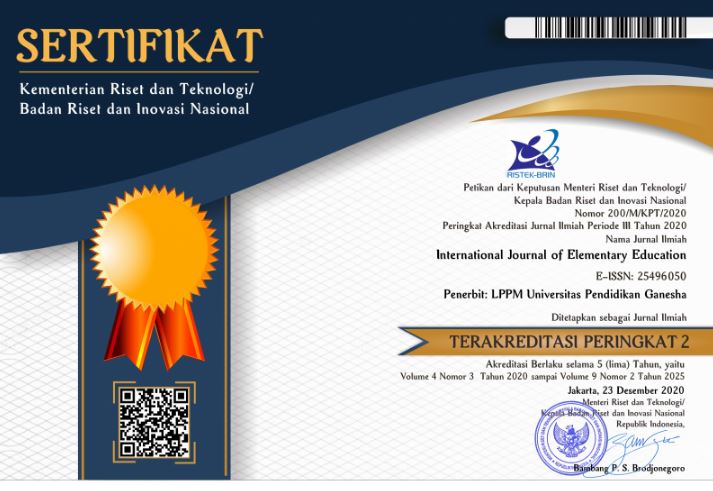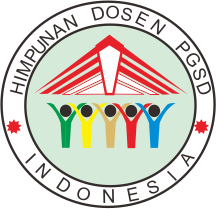Digital Picture Card Media Based on Mother Tongue Assisted with Artificial Intelligence in Literacy Learning for Early Grades
DOI:
https://doi.org/10.23887/ijee.v8i3.84158Keywords:
Digital Picture, Artificial Intelligence, Card Media, Mother Tongue, Literacy LearningAbstract
Elementary school students' literacy skills are still relatively low, this is because students are not yet accustomed to accomplishing literacy activities regularly. This research aims to analyze the effectiveness of digital picture media using mother tongue assisted with AI in literacy learning for early-class students. This study uses a descriptive analysis method with a qualitative approach. Data were obtained through a variety of methods, named: observation, interviews, and analysis of documentation material. In Interviews, the data was collected through the key informants consisting of the principal, vice principal, class teachers, parents, and the retired school principal. The data were analyzed using interactive data rolling, starting from data collection, data presentation, data reduction, and verification of withdrawal. The results of using digital picture card media in literacy learning for early-grade students, digital image media assisted by artificial intelligence can stimulate students' participation and creative abilities to learn, recognize letters, and read simple words and sentences. The role of the mother tongue in language instruction is very important. It helps early-grade students to grasp literacy learning. Third, the use of picture card media based on the mother tongue and artificial intelligence technology is very effective in improving students' abilities in studying literacy, especially reading for early-grade students. These findings reflect that the use of mother tongue-based digital picture media can improve student's abilities in literacy learning.
References
Al Mamun, M. A., Lawrie, G., & Wright, T. (2022). Exploration of learner-content interactions and learning approaches: The role of guided inquiry in the self-directed online environments. Computers & Education, 178, 104398. https://doi.org/10.1016/j.compedu.2021.104398.
Ambarani, P. K. W., Pudjawan, K., & Tirtayani, L. A. (2015). Application of Storytelling Method Assisted by Serial Picture Media to Improve Children’s Listening Skills. Jurnal Pendidikan Anak Usia Dini Undiksha, 3(1), 1–11. https://doi.org/10.23887/PAUD.V3I1.5906.
Anderson, J., Lightfoot, A., & Anderson, J. (2018). Current perceptions and future possibilities Translingual practices in English classrooms in India : current perceptions and future possibilities. International Journal of Bilingual Education and Bilingualism, 0(0), 1–22.
https://doi.org/10.1080/13670050.2018.1548558.
Arya Wiradnyana, I. G., Ardiawan, I., & Km. Agus Budhi A.P. (2020). Inside-Outside Circle Instructional Strategies with Image Media to Enhance Children Language Skills. JPUD - Jurnal Pendidikan Usia Dini, 14(1), 156–168. https://doi.org/10.21009/141.11.
Avando Bastari, Adi Bandono, & Okol Sri Suharyo. (2021). The development strategy of smart campus for improving excellent navy human resources. Global Journal of Engineering and Technology Advances, 6(2), 033–043. https://doi.org/10.30574/gjeta.2021.6.2.0011.
Bastian, A., Awwaluddin, Y., Whydiantoro., & Budiman. (2020). Designing Environtment Care Adventure Game Based on Android Using Construct 2. Jurnal Mantik, 4(3), 1–7.
https://doi.org/10.35335/mantik.Vol4.2021.1136.pp2311-2317.
Bin-Tahir, S. Z., Hanapi, H., I., & Suriaman, A. (2020). Avoiding Maluku Local Languages Death through Embedded Multilingual Learning Model. Uniqbu Journal of Social Sciences (UJSS, 1(1), 53–60. https://doi.org/https://scholar.google.co.id/scholar?hl=id&as_sdt=0%2C5&as_ylo=2020&q=Definisi+PBL&btnG=#d=gs_qabs&u=%23p%3DhVdGS6BRTBkJ.
Domike, G. C., & Odey, E. O. (2014). An evaluation of the major implementation problems of primary school curriculum in cross river state, Nigeria. American Journal of Educational Research, 2(6), 397–401. https://doi.org/10.12691/education-2-6-12.
Dwi Saputra, A., Nurul Fauziah, F., Suwandi, S., & Artikel, S. (2022). Pemanfaatan materi ajar bahasa Indonesia bermuatan kearifan lokal di SMA Negeri 1 Karanganyar (Utilization of Indonesian language teaching materials containing local wisdom at SMA Negeri 1 Karanganyar. KEMBARA: Jurnal Keilmuan Bahasa, Sastra, Dan Pengajarannya, 8(2), 335–348.
https://doi.org/http://ejournal.umm.ac.id/index.php/kembara.
Eğmir, E., Erdem, C., & Koçyiğit, M. (2017). Trends in educational research: A content analysis of the studies published in International Journal of Instruction. International Journal of Instruction, 10(3), 277–294. https://doi.org/10.12973/iji.2017.10318a.
Esi Febrina, & Mukhidin. (2019). Metakognitif sebagai Keterampilan Berfikir Tingkat Tinggi pada Pembelajaran Abad 21. Edusentris: Jurnal Ilmu Pendidikan Dan Pengajaran, 6(1), 25–32. https://doi.org/10.17509/edusentris.v6i1.451.
Evans, R., & Cleghorn, A. (2022). Do student teachers see what learners see? – Avoiding instructional dissonance when designing worksheets. South African Journal of Childhood Education, 12(1). https://doi.org/10.4102/sajce.v12i1.1015.
Fathoni, K., Setiowati, Y., & Muhammad, R. (2020). Rancang Bangun Aplikasi Modul Pembelajaran Satwa Untuk Anak Berbasis Mobile Augmented Reality. Jurnal Media Informatika Budidarma, 4(1), 32. https://doi.org/10.30865/mib.v4i1.1797.
Grimes, D., & Warschauer, M. (2010). Utility in a fallible tool: A multi-site case study of automated writing evaluation. Journal of Technology, Learning, and Assessment, 8(6).
https://ejournals.bc.edu/index.php/jtla/article/view/1625.
Gunansyah, G., Rachmadiyanti, P., & Subagiyo, F. M. (2018). Keterampilan Informasi Melalui Pembuatan Media Literasi. Publikasi Pendidikan, 8(1), 13. https://doi.org/10.26858/publikan.v8i1.4928.
Gupta, T., Burke, K. A., & Greenbowe, T. J. (2022). Shifting the ownership of learning from instructor to students through student-led instructor-facilitated guided-inquiry learning. In Teaching Innovation in University Education: Case Studies and Main Practices, 69–98. https://doi.org/10.4018/978-1-6684-4441-2.ch005.
Haldorai, A., Murugan, S., & Ramu, A. (2021). Evolution, challenges, and application of intelligent ICT education: An overview. Computer Applications in Engineering Education, 29(3), 562–571. https://doi.org/10.1002/cae.22217.
Hanzelik, P. P., Kummer, A., & Abonyi, J. (2022). Edge-Computing and Machine-Learning-Based Framework for Software Sensor Development. Sensors, 22(11), 1–24. https://doi.org/10.3390/s22114268.
Hasanah, A., Milla, S. N., & Triwoelandari, R. (2022). Pengaruh Media Pembelajaran Audio Visual terhadap Hasil Belajar Siswa Kelas VII pada Mata Pelajaran Fiqih MTs di Kota Bogor. As-Syar’i: Jurnal Bimbingan & Konseling Keluarga, 4(3), 290–297. https://doi.org/10.47467/as.v4i3.1616.
Hau, N. H., Cuong, T. V., & Tinh, T. T. (2020). Students and Teachers’ Perspective Of The Importance Of Arts In STEAM Education In Vietnam. Journal of Critical Reviews, 7(11), 666–671.
https://doi.org/10.31838/jcr.07.11.121.
Hidayati, A., & Astuti, S. (2020). Pengembangan Media Pembelajaran Buku Kata Bergambar Berbasis Android Untuk Meningkatkan Kemampuan Menulis. Journal for Lesson and Learning Studies, 3(2). https://doi.org/10.23887/jlls.v3i2.27446.
Ibrahim, R., Leng, N. S., Yusoff, R. C. M., Samy, G. N., Masrom, S., & Rizman, Z. I. (2018). E-learning acceptance based on technology acceptance model (TAM). Journal of Fundamental and Applied Sciences, 9(4S), 871. https://doi.org/10.4314/jfas.v9i4s.50.
Kim, J. (2020). Learning and Teaching Online During Covid-19: Experiences of Student Teachers in an Early Childhood Education Practicum. International Journal of Early Childhood, 52(2), 145–158. https://doi.org/10.1007/s13158-020-00272-6.
Klímová, B., & Seraj, P. M. I. (2023). The use of chatbots in university EFL settings: Research trends and pedagogical implications. In Frontiers in psychology. frontiersin.org.
https://doi.org/10.3389/fpsyg.2023.1131506.
Lai, K., & Hong, K. (2015). Technology use and learning characteristics of students in higher education: Do generational differences exist? British Journal of Educational Technology, 46(4), 725–738. https://doi.org/10.1111/bjet.12161.
Lau, E. Y. H., Li, H., & Rao, N. (2011). Parental involvement and children’s readiness for school in China. Educational Research, 53(1), 95–113. https://doi.org/10.1080/00131881.2011.552243.
Marhamah, M., & Mulyadi, M. (2020). The Effect of Using Word Wall Picture Media and Linguistic Intelligence to Enhance Learning Outcomes of English Vocabularies. Journal of Educational and Social Research, 10(2), 134. https://doi.org/10.36941/jesr-2020-0033.
Marlani, L., & Prawiyogi, A. G. (2019). Penerapan Model Pembelajaran Project Based Learning Untuk Meningkatkan Keterampilan Menulis Puisi Di Sekolah Dasar. Al-Aulad: Journal of Islamic Primary Education, 2(1). https://doi.org/10.15575/al-aulad.v2i1.4427.
Martinez, C., Gomez, M. J., & Benotti, L. (2015). A comparison of preschool and elementary school children learning computer science concepts through a multilanguage robot programming platform. Proceedings of the 2015 ACM Conference on Innovation and Technology in Computer Science Education, 159–164. https://doi.org/10.1145/2729094.2742599.
Nafi’ah, U., Mashuri, & Wijaya, D. N. (2019). The development of digital book of European history to shape the students’ democratic values. International Journal of Emerging Technologies in Learning, 14(6), 147–154. https://doi.org/10.3991/ijet.v14i06.9760.
Ngo, T. T., Vu, N. K. T., & Chi Phan, T. (2022). Developing Self-Study Competence of Students through Experiential Activities in the Digital Environment. Indonesian Journal Of Educational Research and Review, 5(2). https://doi.org/10.23887/ijerr.v5i2.50359.
Nieto-Escamez, F. A., & Roldán-Tapia, M. D. (2021). Gamification as Online Teaching Strategy During COVID-19: A Mini-Review. Frontiers in Psychology, 12(May), 1–9.
https://doi.org/10.3389/fpsyg.2021.648552.
Nursyahrina, H., Retami, L. H., Pratama, R., Salsabil, S. P., & Ihsan, M. T. (2021). the Use of Google Classroom in English Teaching and Learning Process At Senior High School Level. Jurnal Riset Dan Inovasi Pembelajaran, 1(2), 123–133. https://doi.org/10.51574/jrip.v1i2.41.
Purbohadi, D. (2022). Peningkatan Kompetensi Guru pada Pemrograman Robot Artificial Intelligence Artibo. Jurnal Pendidikan Tambusai, 6, 11481–11488. https://doi.org/10.31004/jptam.v6i2.4266.
Purpura, D. J., & Schmitt, S. A. (2019). Cross-domain development of early academic and cognitive skills. Early Childhood Research Quarterly, 46, 1–4. https://doi.org/10.1016/j.ecresq.2018.10.009.
Rahadiantino, L., Fahmi, A., Aparamarta, H. W., Moerad, S. K., & Shiddiqi, A. M. (2022). Implementasi Pembelajaran Artificial Intelligence Bagi Siswa Sekolah Dasar di Kota Batu, Malang, Jawa Timur. Jurnal Inovasi Pendidikan Dan Pembelajaran Sekolah Dasar, 6(1), 92–101.
https://doi.org/10.24036/jippsd.v6i1.115857.
Rahayu, T., Syafril, S., Wati, W., & Yuberti, Y. (2017). The Application of STAD- Cooperative Learning in Developing Integrated Science on Students Worksheet. Jurnal Ilmiah Pendidikan Fisika Al-Biruni, 6(2), 247–254. https://doi.org/10.24042/jipfalbiruni.v6i2.1933.
Ramadanti, E., & Arifin, Z. (2021). Strategies to Improve Beginning Reading Skills through Picture Card Media for Early Childhood in the Islamic Frame and the Perspective of Educational Experts. Journal of Islamic Early Childhood Education, 4(2), 173–187. https://doi.org/10.24014/kjiece.v4i2.12245.
Reed, Y. (2019). Countering linguistic imperialism with stories in the languages of africa: The african storybook initiative as a model for enabling in and out of school literacies. South African Journal of Childhood Education, 9(1), 1–8. https://doi.org/10.4102/sajce.v9i1.637.
Ristanti, F. F., & Arianto, F. (2019). Flash Card Media Utilization To Improve Student Activity and Learning Outcomes of Fauna Distribution Subtopic in Class Xi Ips I Sma Xin Zhong Surabaya. Geosfera Indonesia, 4(2), 90. https://doi.org/10.19184/geosi.v4i2.9968.
Saifudin, A., Setiawan, S., & Anam, S. (2020). The Implementation of Task Based Learning in Teaching Writing Descriptive Text to The Junior High School. Linguistic, English Education and Art (LEEA) Journal, 4(1), 109–125. https://doi.org/10.31539/leea.v4i1.1351.
Saputra, J., Rahmadeny, M., & Jazzawi, I. (2019). The Importance of Sociolinguistics in Foreign Language Education: A Review of Selected Paper. International Journal for Educational and Vocational Studies, 1(4), 299–303. https://doi.org/10.29103/ijevs.v1i4.1415.
Saputri, D. Y., Rukayah, R. R., & Indriayu, M. I. (2018). Integrating Game-based Interactive Media as Instructional Media: Students’ Response. Journal of Education and Learning (EduLearn), 12(4), 638–643. https://doi.org/10.11591/edulearn.v12i4.8290.
Saubari, A. P., & I Gde Wawan Sudatha. (2023). Interactive Learning Multimedia Based on Problem-Based Learning Models in Fifth-Grade Science Content. Journal of Education Technology, 7(1), 177–185. https://doi.org/10.23887/jet.v7i1.57354.
Sefriani, R., & Sepriana, R. (2022). Technology Acceptance Model : the use of E-Study Aplications in. Journal of Education Technology, 6(4), 704–710. https://doi.org/10.23887/jet.v6i4.45457.
Seo, K., Tang, J., Roll, I., Fels, S., & Yoon, D. (2021). The impact of artificial intelligence on learner–instructor interaction in online learning. International Journal of Educational Technology in Higher Education, 18(1), 54. https://doi.org/10.1186/s41239-021-00292-9.
Simanjuntak, S. S., & Listiani, T. (2020). Penerapan Differentiated Instruction dalam Meningkatkan Pemahaman Konsep Matematika Siswa Kelas 2 SD. Scholaria: Jurnal Pendidikan Dan Kebudayaan, 10(2), 134–141. https://doi.org/10.24246/j.js.2020.v10.i2.p134-141.
Simatupang, E. C. M., Sari, P., & Siregar, A. T. B. (2021). The Use of Google Classroom Application to Enhance Toefl Score During Pandemic Covid 19. Review of International Geographical Education Online, 11(6), 617–622. https://doi.org/10.48047/rigeo.11.06.77.
Sudejamnong, A., Robsouk, K., Loipha, S., & Inprasitha, M. (2014). Development of teachers’ mathematical knowledge for teaching by using the innovation of lesson study and open approach. Sociology Mind, 04(04), 317–327. https://doi.org/10.4236/sm.2014.44032.
Suniyasih, N. M., Ratminingsih, N. M., & Budasi, I. G. (2020). Development of Multilingual Thematic Picture Dictionary: A Support for Literacy. Jurnal Pendidikan Dan Pengajaran, 53(3), 236.
https://doi.org/10.23887/jpp.v53i3.27508.
Supriatna, A., & Ediyanto, E. (2021). The Implementation of Multisensory Technique for Children with Dyslexia. IJDS: Indonesian Journal of Disability Studies, 8(01), 279–293.
https://doi.org/10.21776/ub.ijds.2021.008.01.17.
Taufik, M. (2020). Strategic Role of Islamic Religious Education in Strengthening Character Education in the Era of Industrial Revolution 4.0. Jurnal Ilmiah Islam Futura, 20(1), 86–104.
https://doi.org/10.22373/jiif.v20i1.5797.
Taufiq, M., Ghani, A., Hamzah, M., Ramli, S., Ab, W., Daud, A. W., Rijal, T., Romli, M., Najihah, N., & Mokhtar, M. (2019). a Questionnaire-Based Approach on Technology Acceptance Model for Mobile Digital Game-Based Learning. Journal of Global Business and Social Entrepreneurship (GBSE), 5(14), 24621714. http://www.gbse.my/V5 NO.14 (MARCH 2019)/Paper-199-.pdf.
Tegeh, I. M., Santyasa, I. W., Agustini, K., Santyadiputra, G. S., & Juniantari, M. (2022). Group Investigation Flipped Learning in Achieving of Students’ Critical and Creative Thinking Viewed from Their Cognitive Engagement in Learning Physics. Journal of Education Technology, 6(2), 350–362. https://ejournal.undiksha.ac.id/index.php/JET.
Toma, F., Diaconu, D. C., & Popescu, C. M. (2021). The use of the kahoot! learning platform as a type of formative assessment in the context of pre-university education during the covid-19 pandemic period. Education Sciences, 11(10). https://doi.org/10.3390/educsci11100649.
Tsalitsatul Maulidah. (2020). Peningkatan Keterampilan Menulis Puisi Dengan Media Gambar. Karangan: Jurnal Bidang Kependidikan, Pembelajaran, Dan Pengembangan, 2(01), 64–70.
https://doi.org/10.55273/karangan.v2i01.46.
Wei, L. (2023). Artificial intelligence in language instruction: impact on English learning achievement, L2 motivation, and self-regulated learning. Frontiers in Psychology, 14(November), 1–14.
https://doi.org/10.3389/fpsyg.2023.1261955.
Winarni, R., Slamet, S. Y., & Syawaludin, A. (2022). Development of Indonesian language text books with multiculturalism and character education to improve traditional poetry writing skills. European Journal of Educational Research, 10(1), 455–466. https://doi.org/10.12973/EU-JER.10.1.455.
Yaacob, A., & Lubis, A. H. (2022). The Development of Web-Based Teaching Materials Integrated with Indonesian Folklore for Indonesian Language for Foreign Speakers Students. International Journal of Language Education, 6(1), 46–62. https://eric.ed.gov/?id=EJ1343101.
Downloads
Published
How to Cite
Issue
Section
License
Copyright (c) 2024 Yohanes Vianey Sayangan

This work is licensed under a Creative Commons Attribution-ShareAlike 4.0 International License.
Authors who publish with the International Journal of Elementary Education agree to the following terms:
- Authors retain copyright and grant the journal the right of first publication with the work simultaneously licensed under a Creative Commons Attribution License (CC BY-SA 4.0) that allows others to share the work with an acknowledgment of the work's authorship and initial publication in this journal.
- Authors are able to enter into separate, additional contractual arrangements for the non-exclusive distribution of the journal's published version of the work (e.g., post it to an institutional repository or publish it in a book), with an acknowledgment of its initial publication in this journal.
- Authors are permitted and encouraged to post their work online (e.g., in institutional repositories or on their website) prior to and during the submission process, as it can lead to productive exchanges, as well as earlier and greater citation of published work. (See The Effect of Open Access)








